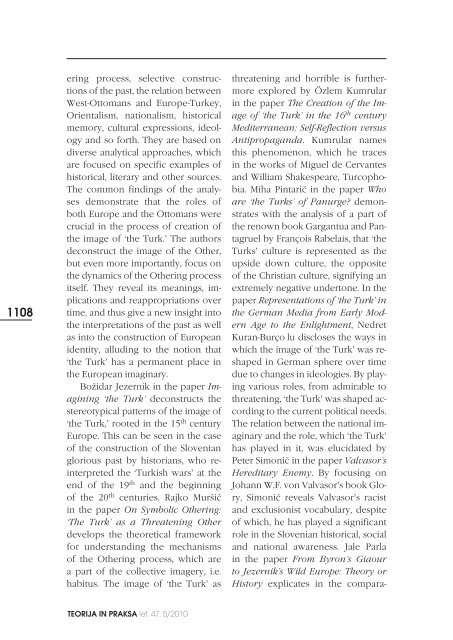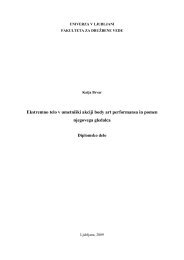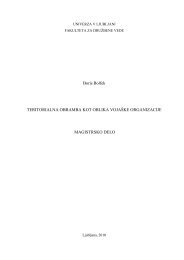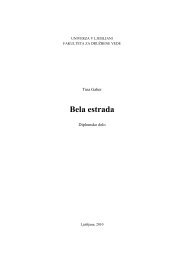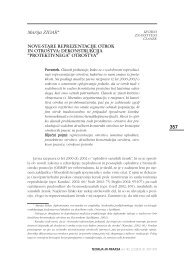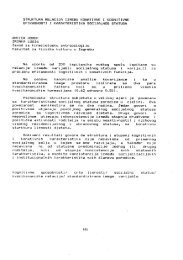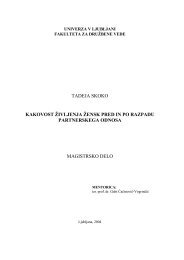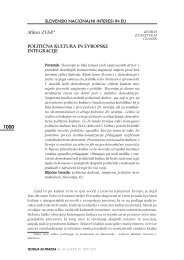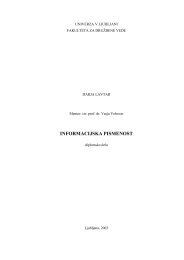Orientalism, dealing with the vast- ness of the Orient-Occident dichot ...
Orientalism, dealing with the vast- ness of the Orient-Occident dichot ...
Orientalism, dealing with the vast- ness of the Orient-Occident dichot ...
Create successful ePaper yourself
Turn your PDF publications into a flip-book with our unique Google optimized e-Paper software.
1108<br />
threatening and horrible is fur<strong>the</strong>rmore<br />
explored by Özlem Kumrular<br />
in <strong>the</strong> paper The Creation <strong>of</strong> <strong>the</strong> Image<br />
<strong>of</strong> ‘<strong>the</strong> Turk’ in <strong>the</strong> 16 th century<br />
Mediterranean: Self-Reflection versus<br />
Antipropaganda. Kumrular names<br />
this phenomenon, which he traces<br />
in <strong>the</strong> works <strong>of</strong> Miguel de Cervantes<br />
and William Shakespeare, Turcophobia.<br />
Miha Pintarič in <strong>the</strong> paper Who<br />
are ‘<strong>the</strong> Turks’ <strong>of</strong> Panurge? demonstrates<br />
<strong>with</strong> <strong>the</strong> analysis <strong>of</strong> a part <strong>of</strong><br />
<strong>the</strong> renown book Gargantua and Pantagruel<br />
by François Rabelais, that ‘<strong>the</strong><br />
Turks’ culture is represented as <strong>the</strong><br />
upside down culture, <strong>the</strong> opposite<br />
<strong>of</strong> <strong>the</strong> Christian culture, signifying an<br />
extremely negative undertone. In <strong>the</strong><br />
paper Representations <strong>of</strong> ‘<strong>the</strong> Turk’ in<br />
<strong>the</strong> German Media from Early Modern<br />
Age to <strong>the</strong> Enlightment, Nedret<br />
Kuran-Burçoğlu discloses <strong>the</strong> ways in<br />
which <strong>the</strong> image <strong>of</strong> ‘<strong>the</strong> Turk’ was reshaped<br />
in German sphere over time<br />
due to changes in ideologies. By playing<br />
various roles, from admirable to<br />
threatening, ‘<strong>the</strong> Turk’ was shaped according<br />
to <strong>the</strong> current political needs.<br />
The relation between <strong>the</strong> national imaginary<br />
and <strong>the</strong> role, which ‘<strong>the</strong> Turk’<br />
has played in it, was elucidated by<br />
Peter Simonič in <strong>the</strong> paper Valvasor’s<br />
Hereditary Enemy. By focusing on<br />
Johann W.F. von Valvasor’s book Glory,<br />
Simonič reveals Valvasor’s racist<br />
and exclusionist vocabulary, despite<br />
<strong>of</strong> which, he has played a significant<br />
role in <strong>the</strong> Slovenian historical, social<br />
and national aware<strong>ness</strong>. Jale Parla<br />
in <strong>the</strong> paper From Byron’s Giaour<br />
to Jezernik’s Wild Europe: Theory or<br />
History explicates in <strong>the</strong> comparaering<br />
process, selective constructions<br />
<strong>of</strong> <strong>the</strong> past, <strong>the</strong> relation between<br />
West-Ottomans and Europe-Turkey,<br />
<strong><strong>Orient</strong>alism</strong>, nationalism, historical<br />
memory, cultural expressions, ideology<br />
and so forth. They are based on<br />
diverse analytical approaches, which<br />
are focused on specific examples <strong>of</strong><br />
historical, literary and o<strong>the</strong>r sources.<br />
The common findings <strong>of</strong> <strong>the</strong> analyses<br />
demonstrate that <strong>the</strong> roles <strong>of</strong><br />
both Europe and <strong>the</strong> Ottomans were<br />
crucial in <strong>the</strong> process <strong>of</strong> creation <strong>of</strong><br />
<strong>the</strong> image <strong>of</strong> ‘<strong>the</strong> Turk.’ The authors<br />
deconstruct <strong>the</strong> image <strong>of</strong> <strong>the</strong> O<strong>the</strong>r,<br />
but even more importantly, focus on<br />
<strong>the</strong> dynamics <strong>of</strong> <strong>the</strong> O<strong>the</strong>ring process<br />
itself. They reveal its meanings, implications<br />
and reappropriations over<br />
time, and thus give a new insight into<br />
<strong>the</strong> interpretations <strong>of</strong> <strong>the</strong> past as well<br />
as into <strong>the</strong> construction <strong>of</strong> European<br />
identity, alluding to <strong>the</strong> notion that<br />
‘<strong>the</strong> Turk’ has a permanent place in<br />
<strong>the</strong> European imaginary.<br />
Božidar Jezernik in <strong>the</strong> paper Imagining<br />
‘<strong>the</strong> Turk’ deconstructs <strong>the</strong><br />
stereotypical patterns <strong>of</strong> <strong>the</strong> image <strong>of</strong><br />
‘<strong>the</strong> Turk,’ rooted in <strong>the</strong> 15 th century<br />
Europe. This can be seen in <strong>the</strong> case<br />
<strong>of</strong> <strong>the</strong> construction <strong>of</strong> <strong>the</strong> Slovenian<br />
glorious past by historians, who reinterpreted<br />
<strong>the</strong> ‘Turkish wars’ at <strong>the</strong><br />
end <strong>of</strong> <strong>the</strong> 19 th and <strong>the</strong> beginning<br />
<strong>of</strong> <strong>the</strong> 20 th centuries. Rajko Muršič<br />
in <strong>the</strong> paper On Symbolic O<strong>the</strong>ring:<br />
‘The Turk’ as a Threatening O<strong>the</strong>r<br />
develops <strong>the</strong> <strong>the</strong>oretical framework<br />
for understanding <strong>the</strong> mechanisms<br />
<strong>of</strong> <strong>the</strong> O<strong>the</strong>ring process, which are<br />
a part <strong>of</strong> <strong>the</strong> collective imagery, i.e.<br />
habitus. The image <strong>of</strong> ‘<strong>the</strong> Turk’ as<br />
TEORIJA IN PRAKSA let. 47, 5/2010


